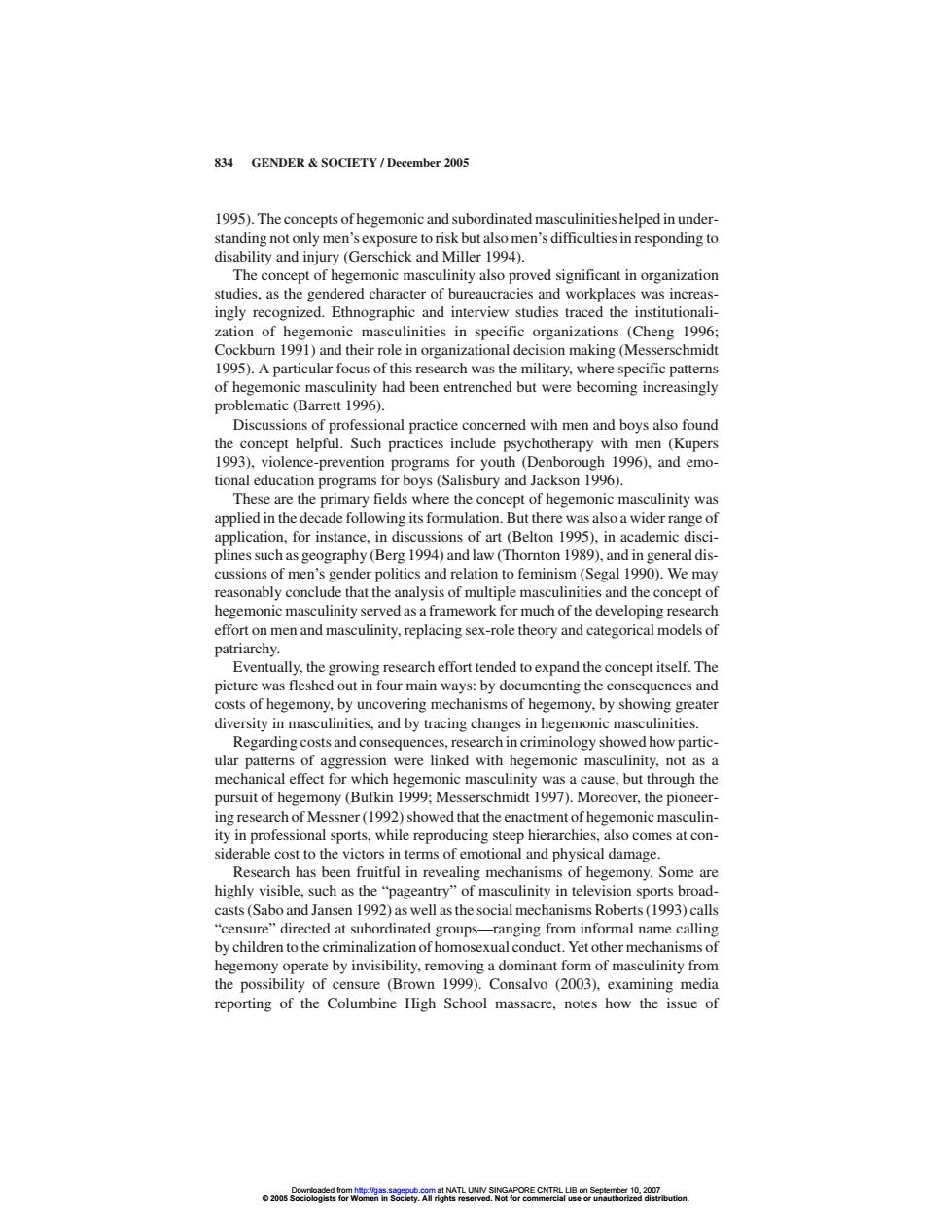正在加载图片...

834 GENDER SOCIETY/December 2005 1995).The concepts of hegemonic and subordinated masculinities helped in under- standing not only men's exposure to risk but also men's difficulties in responding to disability and injury (Gerschick and Miller 1994). The concept of hegemonic masculinity also proved significant in organization studies,as the gendered character of bureaucracies and workplaces was increas- ingly recognized.Ethnographic and interview studies traced the institutionali- zation of hegemonic masculinities in specific organizations (Cheng 1996; Cockburn 1991)and their role in organizational decision making(Messerschmidt 1995).A particular focus of this research was the military,where specific patterns of hegemonic masculinity had been entrenched but were becoming increasingly problematic(Barrett 1996). Discussions of professional practice concerned with men and boys also found the concept helpful.Such practices include psychotherapy with men (Kupers 1993),violence-prevention programs for youth (Denborough 1996),and emo- tional education programs for boys(Salisbury and Jackson 1996). These are the primary fields where the concept of hegemonic masculinity was applied in the decade following its formulation.But there was also a wider range of application,for instance,in discussions of art(Belton 1995),in academic disci- plines such as geography(Berg 1994)and law(Thornton 1989),and in general dis- cussions of men's gender politics and relation to feminism (Segal 1990).We may reasonably conclude that the analysis of multiple masculinities and the concept of hegemonic masculinity served as a framework for much of the developing research effort on men and masculinity,replacing sex-role theory and categorical models of patriarchy. Eventually,the growing research effort tended to expand the concept itself.The picture was fleshed out in four main ways:by documenting the consequences and costs of hegemony,by uncovering mechanisms of hegemony,by showing greater diversity in masculinities,and by tracing changes in hegemonic masculinities. Regarding costs and consequences,research in criminology showed how partic- ular patterns of aggression were linked with hegemonic masculinity,not as a mechanical effect for which hegemonic masculinity was a cause,but through the pursuit of hegemony(Bufkin 1999;Messerschmidt 1997).Moreover,the pioneer- ing research of Messner(1992)showed that the enactment of hegemonic masculin- ity in professional sports,while reproducing steep hierarchies,also comes at con- siderable cost to the victors in terms of emotional and physical damage Research has been fruitful in revealing mechanisms of hegemony.Some are highly visible,such as the"pageantry"of masculinity in television sports broad- casts(Sabo and Jansen 1992)as well as the social mechanisms Roberts(1993)calls "censure"directed at subordinated groups-ranging from informal name calling by children to the criminalization of homosexual conduct.Yet other mechanisms of hegemony operate by invisibility,removing a dominant form of masculinity from the possibility of censure (Brown 1999).Consalvo (2003),examining media reporting of the Columbine High School massacre,notes how the issue of o2oosS6e08a8rmh8Pg532RT4T60w66O2ECTBgarto1827bution1995). The concepts of hegemonic and subordinated masculinities helped in understanding not only men’s exposure to risk but also men’s difficulties in responding to disability and injury (Gerschick and Miller 1994). The concept of hegemonic masculinity also proved significant in organization studies, as the gendered character of bureaucracies and workplaces was increasingly recognized. Ethnographic and interview studies traced the institutionalization of hegemonic masculinities in specific organizations (Cheng 1996; Cockburn 1991) and their role in organizational decision making (Messerschmidt 1995). A particular focus of this research was the military, where specific patterns of hegemonic masculinity had been entrenched but were becoming increasingly problematic (Barrett 1996). Discussions of professional practice concerned with men and boys also found the concept helpful. Such practices include psychotherapy with men (Kupers 1993), violence-prevention programs for youth (Denborough 1996), and emotional education programs for boys (Salisbury and Jackson 1996). These are the primary fields where the concept of hegemonic masculinity was applied in the decade following its formulation. But there was also a wider range of application, for instance, in discussions of art (Belton 1995), in academic disciplines such as geography (Berg 1994) and law (Thornton 1989), and in general discussions of men’s gender politics and relation to feminism (Segal 1990). We may reasonably conclude that the analysis of multiple masculinities and the concept of hegemonic masculinity served as a framework for much of the developing research effort on men and masculinity, replacing sex-role theory and categorical models of patriarchy. Eventually, the growing research effort tended to expand the concept itself. The picture was fleshed out in four main ways: by documenting the consequences and costs of hegemony, by uncovering mechanisms of hegemony, by showing greater diversity in masculinities, and by tracing changes in hegemonic masculinities. Regarding costs and consequences, research in criminology showed how particular patterns of aggression were linked with hegemonic masculinity, not as a mechanical effect for which hegemonic masculinity was a cause, but through the pursuit of hegemony (Bufkin 1999; Messerschmidt 1997). Moreover, the pioneering research of Messner (1992) showed that the enactment of hegemonic masculinity in professional sports, while reproducing steep hierarchies, also comes at considerable cost to the victors in terms of emotional and physical damage. Research has been fruitful in revealing mechanisms of hegemony. Some are highly visible, such as the “pageantry” of masculinity in television sports broadcasts (Sabo and Jansen 1992) as well as the social mechanisms Roberts (1993) calls “censure” directed at subordinated groups—ranging from informal name calling by children to the criminalization of homosexual conduct. Yet other mechanisms of hegemony operate by invisibility, removing a dominant form of masculinity from the possibility of censure (Brown 1999). Consalvo (2003), examining media reporting of the Columbine High School massacre, notes how the issue of 834 GENDER & SOCIETY / December 2005 © 2005 Sociologists for Women in Society. All rights reserved. Not for commercial use or unauthorized distribution. Downloaded from http://gas.sagepub.com at NATL UNIV SINGAPORE CNTRL LIB on September 10, 2007